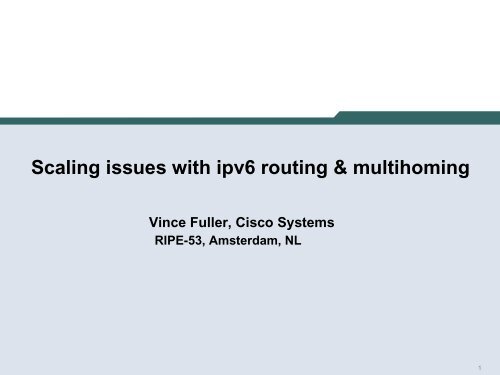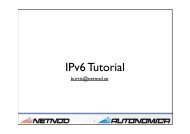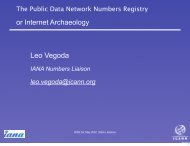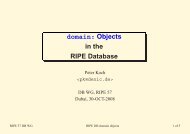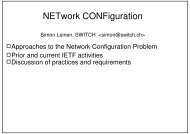PowerPoint Presentation - Basic Concepts in Routing and ... - RIPE 64
PowerPoint Presentation - Basic Concepts in Routing and ... - RIPE 64
PowerPoint Presentation - Basic Concepts in Routing and ... - RIPE 64
Create successful ePaper yourself
Turn your PDF publications into a flip-book with our unique Google optimized e-Paper software.
AcknowledgementsThis is not orig<strong>in</strong>al work, so credit must be given to:• Noel Chiappa for his extensive writ<strong>in</strong>gs over theyears on ID/Locator split• Mike O’Dell for develop<strong>in</strong>g GSE/8+8• Geoff Huston for his ongo<strong>in</strong>g global rout<strong>in</strong>g systemanalysis work (CIDR report, BGP report, etc.)• Jason Schiller for the growth projection section(<strong>and</strong> for tag-team<strong>in</strong>g to present this at NANOG)• Marshall Eubanks for sanity-check<strong>in</strong>g the growthprojections aga<strong>in</strong>st economic reality3
A brief history of Internet time• Recognition of exponential growth – late 1980s• CLNS as IP replacement – December, 1990 IETF• ROAD group <strong>and</strong> the “three trucks” – 1991-1992• Runn<strong>in</strong>g out of “class-B” network numbers• Explosive growth of the “default-free” rout<strong>in</strong>g table• Eventual exhaustion of 32-bit address space• Two efforts – short-term vs. long-term• More at “The Long <strong>and</strong> W<strong>in</strong>d<strong>in</strong>g ROAD”http://rms46.vlsm.org/1/42.html• Supernett<strong>in</strong>g <strong>and</strong> CIDR – 1992-19934
A brief history of Internet time (cont’d)• IETF “ipng” solicitation – RFC1550, Dec 1993• Direction <strong>and</strong> technical criteria for ipng choice –RFC1719 <strong>and</strong> RFC1726, Dec 1994• Proliferation of proposals:• TUBA – RFC1347, June 1992• PIP – RFC1621, RFC1622, May 1994• CATNIP – RFC1707, October 1994• SIP – RFC1710, October 1994• NIMROD – RFC1753, December 1994• ENCAPS – RFC1955, June 19965
A brief history of Internet time (cont’d)• Choice came down to politics, not technical merit• Hard issues deferred <strong>in</strong> favor of packet header design• Th<strong>in</strong>gs lost <strong>in</strong> shuffle…err compromise <strong>in</strong>cluded:• Variable-length addresses• De-coupl<strong>in</strong>g of transport <strong>and</strong> network-layer addresses• Clear separation of endpo<strong>in</strong>t-id/locator (more later)• Rout<strong>in</strong>g aggregation/abstraction• In fairness, these were (<strong>and</strong> still are) hardproblems… but without solv<strong>in</strong>g them, long-termscalability is problematic6
Identity - “what’s <strong>in</strong> a name”?• Th<strong>in</strong>k of an “endpo<strong>in</strong>t-id” as the “name” of a deviceor protocol stack <strong>in</strong>stance that is communicat<strong>in</strong>gover a network• In the real world, this is someth<strong>in</strong>g like “DaveMeyer” - “who” you are• A “doma<strong>in</strong> name” can be used as a human-readableway of referr<strong>in</strong>g to an endpo<strong>in</strong>t-id7
Desirable properties of endpo<strong>in</strong>t-IDs• Persistence: long-term b<strong>in</strong>d<strong>in</strong>g to the th<strong>in</strong>g thatthey name• These do not change dur<strong>in</strong>g long-lived network sessions• Ease of adm<strong>in</strong>istrative assignment• Assigned to <strong>and</strong> by organizations• Hierarchy is along these l<strong>in</strong>es (like DNS)• Portability• IDs rema<strong>in</strong> the same when an organization changesprovider or otherwise moves to a different po<strong>in</strong>t <strong>in</strong> thenetwork topology• Globally unique8
Locators – “where” you are <strong>in</strong> the network• Th<strong>in</strong>k of the source <strong>and</strong> dest<strong>in</strong>ation “addresses”used <strong>in</strong> rout<strong>in</strong>g <strong>and</strong> forward<strong>in</strong>g• Real-world analogy is street address (i.e. 3700Cisco Way, San Jose, CA, US) or phone number(408-526-7128)• Typically there is some hierarchical structure(analogous to number, street, city, state, country orNPA/NXX)9
Desirable properties of locators• Hierarchical assignment accord<strong>in</strong>g to networktopology (“isomorphic”)• Dynamic, transparent renumber<strong>in</strong>g without disrupt<strong>in</strong>gnetwork sessions• Unique when fully-specified, but may be abstracted toreduce unwanted state• Variable-length addresses or less-specific prefixes canabstract/group together sets of related locators• Real-world analogy: don’t need to know exact streetaddress <strong>in</strong> Australia to travel toward it from San Jose• Possibly applied to traffic without end-systemknowledge (effectively, like NAT but without break<strong>in</strong>gthe sacred End-to-End pr<strong>in</strong>ciple)10
GSE benefits• Achieves goal of EID/locator split while keep<strong>in</strong>gmost of ipv6 <strong>and</strong> (hopefully) without requir<strong>in</strong>g anew database for EID-to-locator mapp<strong>in</strong>g• Allows for scalable multi-hom<strong>in</strong>g by allow<strong>in</strong>gseparate RG for each path to an end-system; unlikeshim6, does not require transport-layer complexityto deal with multiple addresses• Renumber<strong>in</strong>g can be fast <strong>and</strong> transparent to hosts(<strong>in</strong>clud<strong>in</strong>g for long-lived sessions) with no need todetect failure of usable addresses14
What about shim6/multi6?• Approx 3-year-old IETF effort to retro-fit anendpo<strong>in</strong>t-id/locator split <strong>in</strong>to the exist<strong>in</strong>g ipv6 spec• Summary: end-systems are assigned an address(locator) for each connection they have to thenetwork topology (each provider); one address isused as the id <strong>and</strong> isn’t expected to change dur<strong>in</strong>gsession lifetimes• A “shim” layer hides locator/id split from transport(somewhat problematic as ipv6 embeds addresses<strong>in</strong> the transport headers)• Complexity around locator pair selection, addition,removal, test<strong>in</strong>g of liveness, etc… to avoid addresschanges be<strong>in</strong>g visible to TCP…all of this <strong>in</strong> hostsrather than routers17
What about shim6/multi6? (cont<strong>in</strong>ued)• Some perceive as an optional, “bag on the side” rather than a partof the core architecture…• Will shim6 solve your problems <strong>and</strong> help make ipv6 both scalable<strong>and</strong> deployable <strong>in</strong> your network?• Feedback thus far: probably not (to be polite…)• SP objection: doesn’t allow site-level traffic-eng<strong>in</strong>eer<strong>in</strong>g <strong>in</strong> mannerof IPv4; TE may be doable but will be very different <strong>and</strong> will addgreater dependency on host implementations <strong>and</strong> adm<strong>in</strong>istration• Host<strong>in</strong>g provider objection: requires too many addresses <strong>and</strong> toomuch state <strong>in</strong> web servers• End-users: still don’t get “provider-<strong>in</strong>dependent addresses” so stillface renumber<strong>in</strong>g pa<strong>in</strong>• Dependencies on end-hosts (vs. border routers with NAT or GSE)have implications for deployment, management, etc.18
What if noth<strong>in</strong>g is changed?• How about a “thought experiment”?• Make assumptions about ipv6 <strong>and</strong> Internet growth• Take a guess at growth trends• Pose some questions about what might happen• What is the “worst-case” scenario that providers,vendors, <strong>and</strong> users might face?19
My cloudy crystal ball: a few assumptions• ipv6 will be deployed <strong>in</strong> parallel to IPv4 <strong>and</strong> will be widelyadopted• IPv4 will be predom<strong>in</strong>ant protocol for near-to-mid term <strong>and</strong>will cont<strong>in</strong>ue to be used <strong>in</strong>def<strong>in</strong>itely• IPv4 rout<strong>in</strong>g state growth, <strong>in</strong> particular that for multihomedsites, will cont<strong>in</strong>ue to grow at a greater than l<strong>in</strong>earrate up to or beyond address space exhaustion; ipv6rout<strong>in</strong>g state growth curve will be similar - driven bymultihom<strong>in</strong>g• As consequence of above, routers <strong>in</strong> the “DFZ” will needto ma<strong>in</strong>ta<strong>in</strong> full rout<strong>in</strong>g/forward<strong>in</strong>g tables for both IPv4 <strong>and</strong>ipv6; tables will cont<strong>in</strong>ue to grow <strong>and</strong> will need to respondrapidly <strong>in</strong> the face of significant churn20
A few more assumptions• ipv6 prefix assignments will be large enough to allowvirtually all organizations to aggregate addresses <strong>in</strong>toa s<strong>in</strong>gle prefix; <strong>in</strong> only relatively few cases (consideracquisitions, mergers, etc.) will multiple prefixes needto be advertised for an organization <strong>in</strong>to the “DFZ”• shim6 will not see significant adoption beyondpossible edge use for multi-hom<strong>in</strong>g of residences <strong>and</strong>very small organizations• IPv4-style multi-hom<strong>in</strong>g will be the norm for ipv6,imply<strong>in</strong>g that all multi-homed sites <strong>and</strong> all sites whichchange providers without renumber<strong>in</strong>g will need to beexplicitly advertised <strong>in</strong>to the “DFZ”21
Even more assumptions• as the Internet becomes more mission-critical agreater fraction of organizations will choose to multihome• IPv4-style traffic eng<strong>in</strong>eer<strong>in</strong>g, us<strong>in</strong>g more-specificprefix advertisements, will be performed with ipv6; thispractice will likely <strong>in</strong>crease as the Internet grows• Efforts to reduce the scope of prefix advertisements,such as AS_HOPCOUNT, will not be adopted on alarge enough scale to reduce the impact of morespecifics<strong>in</strong> the "DFZ"22
Questions to ask or worry about• How much rout<strong>in</strong>g state growth is due toorganizations need<strong>in</strong>g multiple IPv4 prefixes?Some/most of these may be avoided with ipv6.• As a result of available larger prefixes, will thenumber of prefixes per ASN decrease toward one?What is the likelihood that ASN usage growth willrema<strong>in</strong> l<strong>in</strong>ear? (probably low)• Today, approximately 30,000 ASNs <strong>in</strong> use, so IPv4prefixes-per ASN averages around 6-to-1 or so… howmuch better will this be with ipv6? 1-to-1? 2-to-1? More?• How much growth is due to un<strong>in</strong>tentional morespecifics?These may be avoided with ipv6.23
More questions, more worries• How much growth is due to TE or other <strong>in</strong>tentionaluse of more-specifics? These will happen with ipv6unless draconian address allocation rules are kept(which is unlikely)• This appears to be an <strong>in</strong>creas<strong>in</strong>g fraction of the morespecifics• What’s the rout<strong>in</strong>g state “churn rate” <strong>and</strong> is itgrow<strong>in</strong>g, shr<strong>in</strong>k<strong>in</strong>g, or rema<strong>in</strong><strong>in</strong>g steady? (grow<strong>in</strong>gdramatically)• What happens if we add more overhead to therout<strong>in</strong>g protocols/system (th<strong>in</strong>k: SBGP/SoBGP)?• If the rout<strong>in</strong>g table is allowed to grow arbitrarily large,does validation become <strong>in</strong>feasible?24
Geoff Huston’s IPv4 BGP growth report• How bad are the growth trends?• Prefixes: 130K to 170K <strong>in</strong> 2005 (196K as of 10/2006)‣projected <strong>in</strong>crease to ~370K with<strong>in</strong> 5 years‣global routes only – each SP has additional <strong>in</strong>ternal routes• Churn: 0.7M/0.4M updates/withdrawals per day‣projected <strong>in</strong>crease to 2.8M/1.6M with<strong>in</strong> 5 years• CPU use: 30% at 1.5Ghz (average) today‣projected <strong>in</strong>crease to 120% with<strong>in</strong> 5 years• These are guesses based on a limited view of the rout<strong>in</strong>g system<strong>and</strong> on low-confidence projections (cloudy crystal ball); the truthcould be worse, especially for peak dem<strong>and</strong>s• No attempt to consider higher overhead (i.e. SBGP/SoBGP)• Trend l<strong>in</strong>es look exponential or quadratic; this is bad…• 200K (4Q06/1Q07) is an <strong>in</strong>terest<strong>in</strong>g number for some hardware…25
Jason Schiller’s analysis: future rout<strong>in</strong>g state size• Assume that wide spread ipv6 adoption will occur at some po<strong>in</strong>t• Put aside when - just assume it will happen• What is the projection of the of the current IPv4 growth• Internet rout<strong>in</strong>g table• International de-aggregates for TE <strong>in</strong> the Internet rout<strong>in</strong>g table• Number of Active ASes• What is the ipv6 rout<strong>in</strong>g table size <strong>in</strong>terpolated from the IPv4growth projections assum<strong>in</strong>g everyone is do<strong>in</strong>g dual stack <strong>and</strong>ipv6 TE <strong>in</strong> the “traditional” IPv4 style?• Add to this <strong>in</strong>ternal IPv4 de-aggregates <strong>and</strong> ipv6 <strong>in</strong>ternal deaggregates• Ask vendors <strong>and</strong> operators to plan to be at least five years aheadof the curve for the foreseeable future26
Current IPv4 Route Classification• Three basic types of IPv4 routes• Aggregates• De-aggregates from growth <strong>and</strong> assignment of a noncontiguousblock• De-aggregates to perform traffic eng<strong>in</strong>eer<strong>in</strong>g• March 2006 Tony Bates CIDR report showed:DatePrefixes Prefixes CIDR Agg14-03-06 180,219 119,114• Can assume that 61K <strong>in</strong>tentional de-aggregates27
Estimated IPv4+ipv6 Rout<strong>in</strong>g Table SizeAssume that tomorrow everyone does dual stack...Current IPv4 Internet rout<strong>in</strong>g table:180K routesNew ipv6 routes (based on 1 prefix per AS):+ 21K routesIntentional de-aggregates for IPv4-style TE:+ 61K routesInternal routes for tier-1 ISP+ 50K to 150K routesInternal customer de-aggregates+ 40K to 120K routes(projected from number of customers)Total size of tier-1 ISP rout<strong>in</strong>g table352K to 532K routesGiven that tier-1 ISPs require IP forward<strong>in</strong>g <strong>in</strong> hardware(6Mpps), these numbers easily exceed the current FIBlimitations of some deployed routers28
What this <strong>in</strong>terpolation doesn’t <strong>in</strong>clude• A s<strong>in</strong>gle AS that currently has multiple non-contiguousassignments that would still advertise the same number ofprefixes to the Internet rout<strong>in</strong>g table if it had a s<strong>in</strong>glecontiguous assignment• All of the ASes that announce only a s<strong>in</strong>gle /24 to theInternet rout<strong>in</strong>g table, but would announce more specificsif they were generally accepted (assume these customersget a /48 <strong>and</strong> up to /<strong>64</strong> is generally accepted)• All of the networks that hide beh<strong>in</strong>d multiple NATaddresses from multiple providers who change the NATaddress for TE. With ipv6 <strong>and</strong> the removal of NAT, theymay need a different TE mechanism.• All of the new ipv6 only networks that may pop up: Ch<strong>in</strong>a,Cell phones, coffee makers, toasters, RFIDs, etc.29
Project<strong>in</strong>g IPv6 Rout<strong>in</strong>g Table Growth• Let’s put aside the date when wide spread IPv6 adoption willoccur• Let’s assume that wide spread IPv6 adoption will occur atsome po<strong>in</strong>t• What is the projection of the of the current IPv4 growth• Internet rout<strong>in</strong>g table• International de-aggregates for TE <strong>in</strong> the Internet rout<strong>in</strong>g table• Number of Active ASes• What is the IPv6 rout<strong>in</strong>g table size <strong>in</strong>terpolated from the IPv4growth projections assum<strong>in</strong>g everyone is do<strong>in</strong>g dual stack<strong>and</strong> IPv6 TE <strong>in</strong> the “traditional” IPv4 style?• Add to this <strong>in</strong>ternal IPv4 de-aggregates <strong>and</strong> IPv6 <strong>in</strong>ternal deaggregates• Ask vendors <strong>and</strong> operators to plan to be at least five yearsahead of the curve for the forseeable future30
Trend: Internet CIDR InformationTotal Routes <strong>and</strong> Intentional de-aggregates31
Trend: Internet CIDR InformationActive ASes32
Future Projection of IPv6 Internet Growth(IPv4 Intentional De-aggregates + Active ASes)33
Future Projection of Comb<strong>in</strong>edIPv4 <strong>and</strong> IPv6 Internet Growth34
Tier 1 Service ProviderIPv4 Internal de-aggregates35
Future Projection Of Tier 1 Service ProviderIPv4 <strong>and</strong> IPv6 Internal de-aggregates36
Future Projection Of Tier 1 Service ProviderIPv4 <strong>and</strong> IPv6 Rout<strong>in</strong>g Table37
Summary of scary numbersRoute type 2006.03 5 years 7 years 10 Years 14 yearsIPv4 Internet routes 180,219 285,0<strong>64</strong> 338,567 427,300 492,269IPv4 CIDR Aggregates 119,114IPv4 <strong>in</strong>tentional de-aggregates 61,105 144,253 195,176 288,554 362,304Active Ases 21,<strong>64</strong>6 31,752 36,161 42,766 47,176Projected ipv6 Internet routes 82,751 179,481 237,195 341,852 423,871Total IPv4/ipv6 Internet routes 262,970 4<strong>64</strong>,545 575,762 769,152 916,140Internal IPv4 low number 48,845 88,853 117,296 173,422 219,916Internal IPv4 high number 150,109 273,061 360,471 532,955 675,840Projected <strong>in</strong>ternal ipv6 (low) 39,076 101,390 131,532 190,245 238,494Projected <strong>in</strong>ternal ipv6 (high) 120,087 311,588 404,221 584,655 732,933Total IPv4/ipv6 routes (low) 350,891 654,788 824,590 1,132,819 1,374,550Total IPv4/ipv6 routes (high) 533,166 1,049,194 1,340,453 1,886,762 2,324,91338
An upper bound? (Marshall Eubanks on PPML)• Are these numbers ridiculous?• How many multi-homed sites could there really be? Consideras an upper-bound the number of small-to-mediumbus<strong>in</strong>esses worldwide• 1,237,198 U.S. companies with >= 10 employees• (from http://www.sba.gov/advo/research/us_03ss.pdf)• U.S. is approximately 1/5 of global economy• Suggests up to 6 million bus<strong>in</strong>esses that might want to multihomesomeday… would be 6 million routes if multi-hom<strong>in</strong>g isdone with “provider <strong>in</strong>dependent” address space• Of course, this is just a WAG… <strong>and</strong> doesn’t consider otherfactors that may or may not <strong>in</strong>crease/decrease a dem<strong>and</strong> formulti-hom<strong>in</strong>g (mobility? <strong>in</strong>dividuals’ personal networks, …?)39
Big ConcernsCurrent equipment purchases• Assum<strong>in</strong>g wide spread IPv6 adoption by 2011• Assum<strong>in</strong>g equipment purchased today should last <strong>in</strong> thenetwork for 5 years• All equipment purchased today should support 1M routesNext generation equipment purchases• Assum<strong>in</strong>g wide spread IPv6 adoption by 2016• Assum<strong>in</strong>g equipment purchased <strong>in</strong> 2012 should last <strong>in</strong> thenetwork for 5 years• Vendors should be prepared to provide equipment that scalesto 1.8M routes40
Concerns <strong>and</strong> questions• Can vendors plan to be at least five years ahead ofthe curve for the foreseeable future?• How do operator certification <strong>and</strong> deployment planslengthen the amount of time required to be ahead ofthe curve?• Do we really want to embark on a rout<strong>in</strong>g tablegrowth / hardware size escalation race for theforeseeable future? Will it be cost effective?• Is it possible that rout<strong>in</strong>g table growth could be sorapid that operators will be required to start a newround of upgrades prior to f<strong>in</strong>ish<strong>in</strong>g the currentround? (remember the 1990s?)41
What’s next?• Is there a real problem here? Or just “chicken little”?• Should we socialize this anywhere else?• Is the Internet operations community <strong>in</strong>terested <strong>in</strong>look<strong>in</strong>g at this problem <strong>and</strong> work<strong>in</strong>g on a solution?Where could/should the work be done?• IETF? Been there – IAB/IESG not very receptive• but soon an IAB workshop (good news?)• NANOG/<strong>RIPE</strong>/APRICOT?• ITU? YFRV? Research community? Other suggestions?• Some discussion earlier this year at:architecture-discuss@ietf.orgppml@ar<strong>in</strong>.net• Sign up to help at: ipmh-<strong>in</strong>terest@external.cisco.com42
Recommended Read<strong>in</strong>g“Endpo<strong>in</strong>ts <strong>and</strong> Endpo<strong>in</strong>t names: A Proposed Enhancement tothe Internet Architecture”, J. Noel Chiappa, 1999,http://users.exis.net/~jnc/tech/endpo<strong>in</strong>ts.txt“On the Nam<strong>in</strong>g <strong>and</strong> B<strong>in</strong>d<strong>in</strong>g of Network Dest<strong>in</strong>ations”, J.Saltzer, August, 1993, published as RFC1498,http://www.ietf.org/rfc/rfc1498.txt?number=1498“The NIMROD Rout<strong>in</strong>g Architecture”, I. Cast<strong>in</strong>eyra, N. Chiappa,M. Steenstrup. February 2006, published as RFC1992,http://www.ietf.org/rfc/rfc1992.txt?number=1992“2005 – A BGP Year <strong>in</strong> Review”, G. Huston, APRICOT 2006,http://www.apnic.net/meet<strong>in</strong>gs/21/docs/sigs/rout<strong>in</strong>g/rout<strong>in</strong>gpres-huston-rout<strong>in</strong>g-update.pdf43


